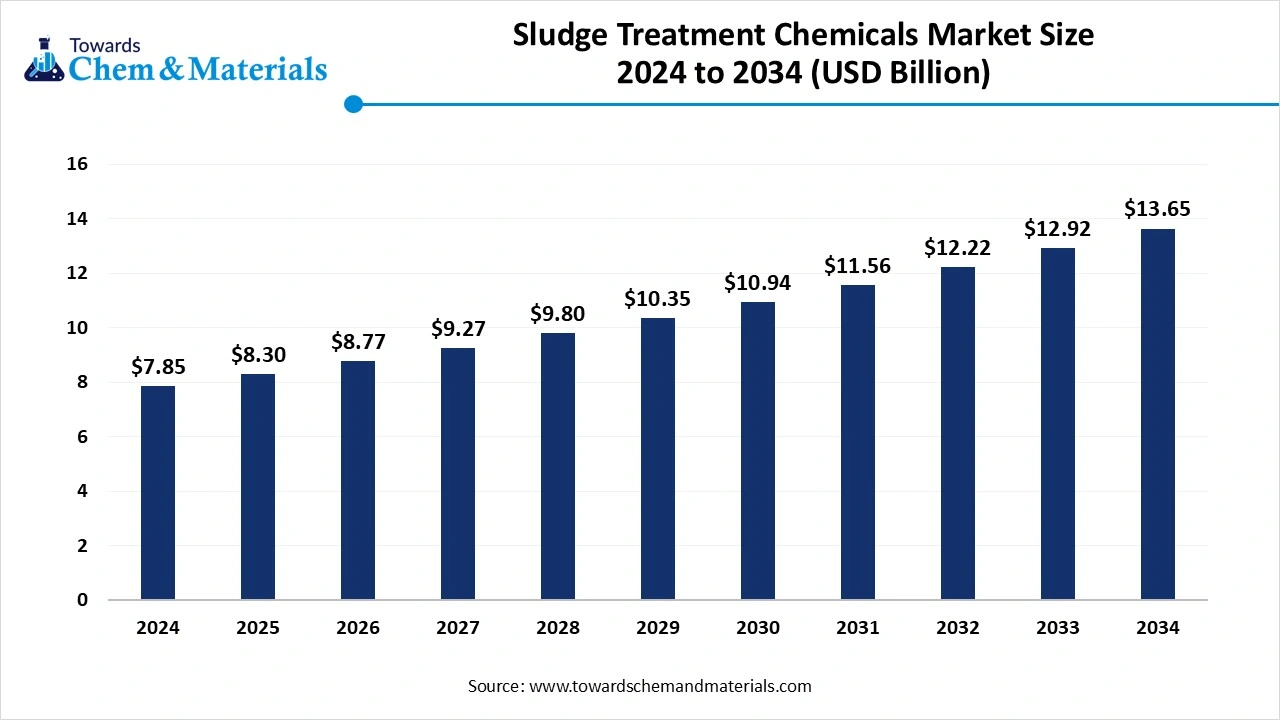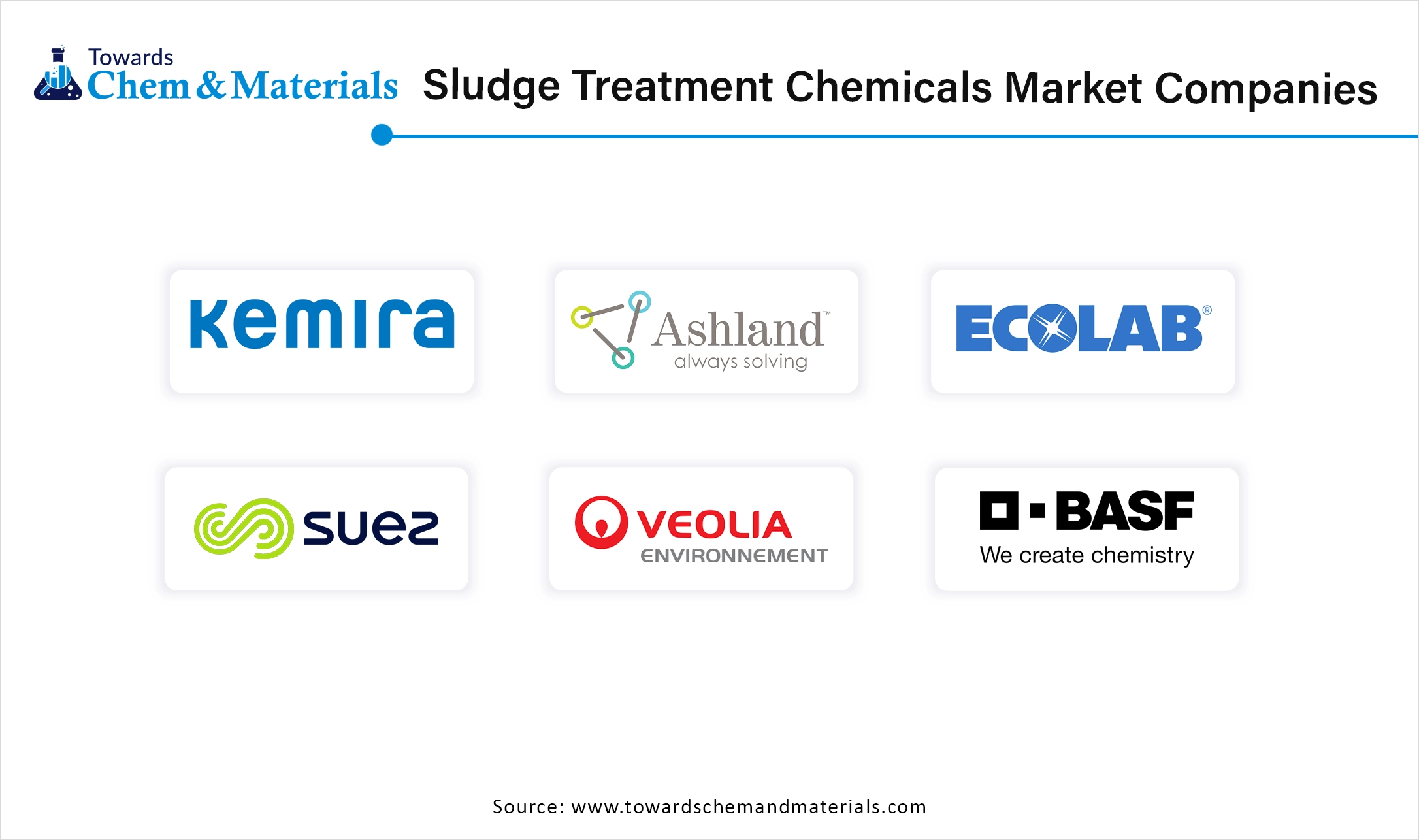December 2025
The global sludge treatment chemicals market size accounted for USD 7.85 billion in 2024 and is predicted to increase from USD 8.30 billion in 2025 to approximately USD 13.65 billion by 2034, expanding at a CAGR of 6.55% from 2025 to 2034. The growing industrialization, rising sludge generation, and growing environmental awareness drive the market growth.

Sludge treatment chemicals are chemicals used to prepare, condition, and treat sludge. These chemicals help to improve the efficiency of processes such as digestion, thickening, and dewatering. The different types of chemicals used for sludge treatment include lime, coagulants, and flocculants that help in disinfection, particle aggregation, and pH adjustment.
The coagulants include chemicals like ferric chloride and aluminium sulfate that help to destabilize sludge particles. Flocculants are high-molecular-weight polymers that act as a bridge between sludge particles. Calcium hydroxide, known as lime, which used in alkaline stabilization to lower the sludge’s odor, pathogenic microorganisms, and putrescence. The pH adjusters include bases like lime and acids like sulfuric acid that are used to adjust the sludge pH. The common chemicals used in sludge treatments are ferric chloride, alum, lime, sodium hypochlorite, chlorinated copperas, polyaluminium chloride, and sodium bisulfite.
The growing demand for water conservation and improving wastewater treatment increases the demand for sludge treatment chemicals. Increasing sludge treatment plant infrastructure helps in the market growth. Factors like rapid population growth, growing industrialization, stringent regulations about sludge disposal & wastewater treatment, development of efficient sludge treatment, and growing environmental awareness contribute to the overall growth of the sludge treatment chemicals market.
The rapid growth in urbanization in many countries increases the sludge water production. Factors like growing populations in some countries, rapid growth in industrialization, and increased wastewater volume increase demand for effective chemicals for sludge treatment. The growing urban areas generate more wastewater, and a high volume of wastewater consists of more sludge, which requires effective treatment.
The increasing population in many urban areas is leading to more generation of wastewater and sludge. The growing urbanization increases demand for advanced treatment methods to comply with stringent regulations and address environmental problems. The growing expansion of cities increases demand for chemicals like disinfectants, coagulants, and flocculants for effective sludge treatment. Urbanization helps in the growth of industrialization, which increases wastewater generation. Industrialization is responsible for increased sludge volume, which increases demand for effective treatments. The growing urbanization is a key driver for the sludge treatment chemicals market growth.

| Report Attributes | Details |
| Market Size in 2025 | USD 8.30 Billion |
| Expected Size by 2034 | USD 13.65 Billion |
| Growth Rate of 2025 to 2034 | CAGR 6.55% |
| Base Year of Estimation | 2024 |
| Forecast Period | 2025-2034 |
| High Dominant Region | North America |
| Segment Covered | By Type, By Treatment, By Application, By Region |
| Key Companies Profiled | Kemira Oyj, Ecolab Inc., BASF SE, SNF Group, Veolia Environment S.A., Kurita Water Industries Ltd., Feralco Group, Suez S.A., Buckman Laboratories International Inc., ChemTreat, Inc., Accepta Ltd., Solenis LLC, AkzoNobel N.V, Thermax Limited, GE Water & Process Technologies, Hubbard-Hall Inc., Aditya Birla Chemicals, Chembond Chemicals Limited, Genesys International Limited. |
The growing innovation and development of effective sludge treatment methodologies create opportunities for sludge treatment chemicals market growth. Innovating new application methods and chemical formulations helps in the market growth. Advancements in anaerobic digestion, like thermal hydrolysis, disintegration techniques, and microaerobic conditions to improve sludge digestibility that help in the market growth.
Innovations in chemical conditioning and the development of advanced membrane filtration techniques to reduce sludge volume, which helps in the market growth. The growing integration of AI and Machine learning helps to optimize treatment processes and increases efficiency. Developments like the use of innovative materials like biochar, composting, and odor control drive market growth. The ongoing innovation in the development of new treatments to reduce environmental impact and improve efficiency creates an opportunity for the growth of the sludge treatment chemicals.
The sludge treatment chemicals consist of several benefits, but high operational costs may restrain the growth of the market. The high cost of chemicals impacts the cost of disposal and operational expenses. The high cost of flocculants increases the overall cost. Flocculants help in clumping sludge particles together, and they are organic polymers; due to this, their cost is high. Many chemicals originate from specialty chemicals & petroleum, which increases the cost of chemicals.
Disinfectants used in sludge treatment, like ultraviolet light, chlorine, and ozone, kill harmful pathogens in sludge cost varies depending on the specific disinfectant. Energy-intensive processes like electrocoagulation, drying, and incineration require high cost. The cost required for maintaining and building facilities like sludge disposal & digesters increases the overall operational cost. The use of some flocculants and coagulants to improve sludge dewatering leads to a higher cost. The high cost can limit the adoption of sludge treatment in some industries, which hampers the growth of the sludge treatment chemicals market.
North America dominated the sludge treatment chemicals market in 2024. The growing urbanization & industrialization in the region increase sludge production, which helps in the growth of the market. The well-developed wastewater treatment increases the volume of sludge, fueling demand for the market. The stringent environmental regulations increase demand for sludge treatment in various industries, driving demand for effective sludge treatment chemicals. The presence of major manufacturers produces various sludge treatment chemicals. Additionally, the growing utilization of sludge in agriculture as a soil amendment and fertilizer increases demand for sludge treatment chemicals, driving the overall growth of the market.
The United States is a major contributor to the sludge treatment chemicals market. The extensive regulatory framework for sludge disposal and management, and regulations aim to handle & dispose of sewage sludge helps in the growth of the market. The growing urbanization and industrialization increase the amount of sludge generation, driving demand for sludge treatment chemicals. The well-developed wastewater treatment infrastructure produced a significant volume of sludge, which increases demand for effective sludge treatment chemicals. Furthermore, the presence of major sludge treatment chemical manufacturers drives innovation and development, contributing to the market growth.
Asia Pacific expects the fastest growth in the market during the forecast period. The growing population in various countries in the region leads to more generations of wastewater helps in the growth of the market. The growing expansion of industries increases industrial wastewater, which fuels demand for sludge treatment chemicals.
The increasing number of wastewater treatment plants increases the volume of sludge that requires effective sludge treatment chemicals. The government implements stringent environmental regulations about wastewater treatment drives the growth of the market. The expansion of various sectors in the region, like chemical manufacturing, oil & gas, and food & beverages, and the growing utilization of sludge in the agricultural sector support the overall growth of the market.
China is a key player in the sludge treatment chemicals market. The generation of a high volume of sludge in the industrial and municipal sector in the region helps in the market growth. The rapid growth in the population and growing urbanization are leading higher volume of sludge, fueling demand for sludge treatment chemicals. The growing investment in expanding wastewater treatment infrastructure is leading sludge production, which increases demand for sludge treatment chemicals. The growth in industries like oil & gas, chemicals, and food & beverage supports the overall growth of the market.
The coagulants segment held the largest share of the sludge treatment chemicals market in 2024. The wide applications in various industries like oil & gas, mining, and paper & pulp help in the growth of the market. Coagulants are used for treating high-turbidity wastewater. The effectiveness in removing impurities and suspended solids during the sludge treatment process increases demand for coagulants.
The fine particles in solution come together to form more easily settleable, larger particles and substances that promote the process of coagulation known as coagulants. The growing technological advancements in coagulant technology help in the market growth. Additionally, the growing demand for biodegradable or eco-friendly water treatment chemicals contributes to the market growth.
The flocculants segment is the fastest growing in the sludge treatment chemicals market during the forecast period. The growing strict environmental regulations and increasing volume of industrial wastewater help in the growth of the market.
Strict environmental regulations increase demand for an effective water clarification process, which fuels demand for flocculants. Growing innovation in polymer-based flocculants to enhance versatility helps in the market growth. The rapid industrial growth and growing public awareness about sludge management & wastewater treatment increase demand for flocculants, further fueling the market growth.
The primary segment dominated the sludge treatment chemicals market in 2024. Primary treatment involves processes like filtration & sedimentation, which help to remove a significant portion of pollutants & solids from wastewater. These treatments use chemicals like flocculants and coagulants, which help to collect smaller particles into larger ones. The growing demand for chemical treatment to improve sludge stabilization & dewatering and the increasing volume of sludge generated in industrial and municipal wastewater treatment drive the growth of the market.
The tertiary segment expects the fastest growth in the market during the forecast period. The growing environmental concerns and stringent standards & regulations for wastewater discharge help in the growth of the market. Tertiary treatment removes pathogens and residual pollutants to avoid the risk of waterborne diseases. The growing demand for the production of higher-quality effluent for purposes like indirect potable reuse, irrigation, and industrial cooling drives the market growth. Furthermore, growing advancements in the development of efficient tertiary treatment methodologies like biological treatment systems & advanced membrane technologies contribute to the growth of the market.
The food & beverages segment held the largest share of the sludge treatment chemicals market in 2024. The processing of various products like packaged beverages, packaged foods, and agricultural inputs generates a large amount of wastewater, which increases the volume of sludge, which helps in the growth of the market. Stringent environmental regulations for the food & beverage industry increase demand for effective sludge management. The manufacturing & processing activities in the food & beverage industry increase the volume of solid waste, like organic matter, food particles, and debris, which increases the amount of sludge. Additionally, complex processing in the food & beverage industry increases demand for an effective sludge treatment process, further supporting the market growth.
The personal care & chemicals segment is the fastest growing in the market during the forecast period. The rapid expansion of the personal care industry increases the production of sludge due to preservatives and various ingredients that help in the growth of the market. The stringent environmental regulations about sludge treatment and disposal increase demand for sludge treatment chemicals. Personal care product formulation generates sludge from primary processes, chemical precipitation, and sedimentation, fueling demand for sludge treatment chemicals. Furthermore, growing personal care products and rising demand for chemicals in various industries support the overall growth of the market.
Asahi Kasei
Memsift Innovations and Murugappa Group
Gradient

By Type
By Treatment
By Application
By Region
December 2025
December 2025
December 2025
November 2025